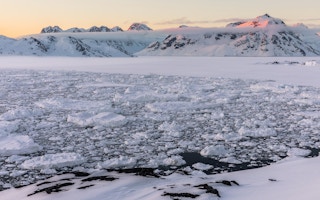At the start of August, for the second time this year, a corridor of open water developed along the north shore of Greenland, this one more than 100 kilometres (over 62 miles) wide. The ice very nearly melted out enough to make the island country circum-navigable, as some sea ice pundits put it, for the first time in human history. Now, scientists say, the oldest and thickest ice in the Arctic is beginning to break up.
We’re unlikely to see a new record sea ice extent minimum in the Arctic Ocean come September 2018, despite entering the summer melt season with ice coverage lower than that at the same time during the record-low year of 2012. Sea ice extent in the Arctic is currently clocking in at 5.396 million square kilometres (about 2.1 million square miles). That’s the good news. (The 2012 record was set at 3.387 million square kilometres on September 17.) But the melt-out above Greenland has alarming implications for the future. If even the thickest, oldest ice is now susceptible to increased warming and changes in weather, what hope is there for the rest of the Arctic?
“
The ice is more broken up. It’s thinner. It’s less resistant to wind. That’s a pretty stark change in the Arctic and in that region in particular.
Walt Meier, research scientist, National Snow and Ice Data Center
The waters around Cape Morris Jesup on Greenland’s north coast are typically so frozen solid that they’re known as the “last ice area.” It was assumed this region would be the final refuge for sea ice under global warming. Yet the open water area extended all the way from Fram Strait to the Lincoln Sea this summer.
Though this year’s openings were driven more by wind than by hotter temperatures, future temperature spikes are cause for concern. The Cape Morris Jesup weather station recorded 10 days above freezing in February—in a place usually sitting below -20 degrees Celsius (-4 Fahrenheit) at that time of year.
“It’s hard to say if this has happened before,” Walt Meier, a research scientist at the National Snow and Ice Data Center, told Mongabay. The satellite record that tracks such things only dates back to 1979. “If it has happened in the past it’s been extremely rare.” He added that the opening earlier this year—around February when ice is nearly reaching its maximum —extent was even rarer.
Sea ice is constantly moving across the Arctic. The Arctic Ocean’s Transpolar Drift Stream pushes ice away from Siberia and piles it up around northern Greenland and the Canadian Archipelago, like rubble in thick ridges around four to five meters thick. Some spots are as much as 20 meters thick. As this multi-year ice continues to get pushed up against the coast, it’s unable to move. “It’s pretty strong, solid ice,” he said.
But this summer, southerly winds in a high-pressure system pulled the ice away from the coast, creating an unexpected opening. Though the area often experiences more northerly winds, southerly winds aren’t entirely uncommon, meaning this could happen again.
In years prior, the ice was too solid for a change in wind direction or force to budge it by much. But what this summer showed is that the “last ice area” is significantly weaker than it has been in the past.
Even if this break-up has happened before, it’s likely that it’s taking less extreme conditions for it to occur now. “Just one extended period of winds blowing north or northwest, et voilà, one can almost circumnavigate Greenland. It says something about the state of the ice,” sea ice enthusiast Neven Curlin observed in his Arctic Sea Ice Blog.
Meier agreed: “The ice is more broken up. It’s thinner. It’s less resistant to wind. That’s a pretty stark change in the Arctic and in that region in particular.”
It’s also a change unlikely to affect Greenland’s waters alone.
Off the coast of Barrow and Prudhoe Bay, Alaska, there’s another patch of thick, multi-year ice. But it’s separated from the main icepack, bobbing out in the ocean on its own. In a normal year, the sea ice would melt from the coast inward—a fringe of open water along the coast, followed by an impenetrable ice pack in the larger ocean. But thicker chunks have increasingly gone floating off by themselves over the past decade. And their increased surface area makes them more susceptible to melting.
After the southerly winds that opened up Greenland’s north coast in February died down, the region refroze—albeit as thinner ice, which made the second open-water period this August all the more possible. Curlin, however, noted that will not happen again. “Not until September,” he wrote. “If it closes again, it will be because northerly winds push the ice back towards the Greenland coast.”
This story was published with permission from Mongabay.com










